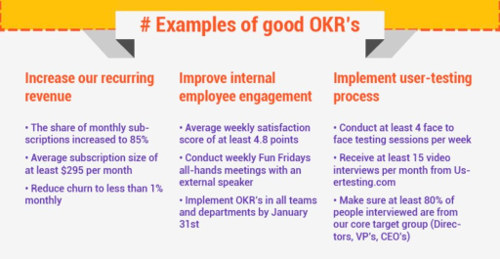
Is your company looking for new, effective ways to set and achieve business goals? OKRs – Objectives and Key Results – use a simple management framework to help everyone in the organisation see and make progress towards set common goals.
The OKR approach was first introduced by Intel’s Andy Grove in the late 1970s and popularised by John Doerr’s seminal leadership book Measure What Matters. It soon revolutionised management thinking among many high achieving Silicon Valley companies including tech giants Google and Twitter before becoming a widely accepted practice for organisations of any type and size.
So, how does it all work?
Every company looks to drive performance and setting organisational, departmental and individual goals to get there is a widely accepted practice. However, top-down goal setting frameworks often end up getting stuck in the mire rather than moving forward.
Objectives and Key Results (OKRs) are a deceptively simple tool that can help a company achieve its goals in double quick time by defining specific, measurable actions, then communicating and monitoring progress towards them.
- Objectives are top strategic priorities. They must be defined as short, inspirational goals for your company, team and individuals, and no more than 3-5 per quarter. Objectives should be ambitious, qualitative, time bound and actionable.
- Key Results are the 2-5 deliverables that are defined for each objective, so that progress can be measured. They should be quantifiable, and achievable but at a stretch. Key results are based on growth, performance, revenue or engagement; they can be numerical or binary.
Here’s an excellent example of how this might look in practice.
Source: TrelloSome key principles
Setting OKRs in your organisation should follow these leading principles as a framework for goal management.
- Simple and agile
OKRs should be set every month or quarter to adapt to changing conditions. With a user friendly framework, this should be a quick process. Resources are dedicated to getting on with the business of achieving your goals and communicating with your team, not getting stuck in planning mode.
- Clear and aligned
OKRs are defined as a team, transparent to everyone. This helps to ensure that all individuals, teams and departments in your organisation are on the same page, with values aligned, moving in the same direction and striving for the same outcomes.
- Bottom up and top down
While company strategic OKRs are set at the top level, goal setting does not cascade downwards. Rather, every team member, group and department builds their own tactical OKRs to feed into the overall strategy, making the entire process more engaging, efficient and effective.
- Collaborative approach
With OKRs, every staff member feels that s/he has a critical role to play in achieving strategic business goals. Since everyone in the company is moving in the same direction towards a common objective, it’s clear that effective team work is the only way to get there.
Benefits of OKRs
It is certainly no exaggeration to say that much of the stellar commercial successes of companies such as Google and LinkedIn can be attributed to their commitment to using the OKR framework. What’s more, there are many other fast growing companies enthusiastically following in their footsteps.
Implemented correctly, with conviction and consistency, the benefits of the OKR framework are as manifold as they are powerful. Here are the main ones:
OKRs encourage the company to really stretch. Unlike many traditional business planning approaches where 100% achievement of objectives is expected, OKRs encourage teams to set bold, ambitious goals that every individual is inspired to push for. It’s the great strides in performance – even if only 60-70% of the target is reached – that propel the company forward.
OKRs are reviewed and updated frequently – monthly or quarterly, not annually. This is much more practical and effective in today’s fast paced business environments where a company’s adaptability and flexibility to react to changing requirements is key.
The ‘key results’ part of this approach is objectively measurable, and constitutes an accurate tracking device with quantifiable building blocks and milestones towards success. This takes the guesswork out of what an achieved objective might look like, and what exact steps should be taken to deliver the desired outcomes.
Enhanced team engagement is the result of a system that isn’t designed to be top down. With individuals, teams and departments having the freedom to develop their own objectives and key results that feed into the overall strategic priorities of the business, meaning and purpose is restored in a process where everyone takes ownership of the goals.
Finally, it is liberating and inspiring for everyone in the business to know that this approach is purely focused on goals and objectives, without any ramifications (good or bad) in terms of pay and performance rewards. OKRs are designed to encourage ambitious results that may not be achieved in full. Tying them to pay and bonuses would fundamentally alter behaviours and discourage taking risks.
- Log in to post comments

